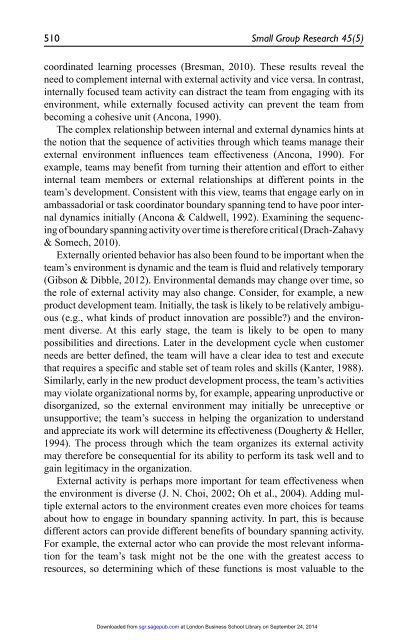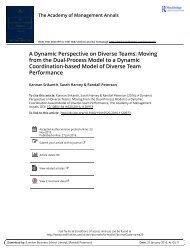The Process of Team Boundary Spanning in Multi-Organizational Contexts - Sarah Harvey, Randall S. Peterson, and N. Anand
Work teams must increasingly operate in complex environments characterized by multiple external actors beyond team and organizational boundaries. Although previous research demonstrates the importance of boundary spanning activities to team effectiveness, it reveals relatively little about the process of boundary spanning in these environments. In this article, we investigated the processes of boundary spanning across multiple external actors in 10 cross-organizational teams. We identified three sequences for reaching out to external actors: (a) moving inside-out from vertical actors inside the host organization to horizontal actors outside of the host organization, (b) moving outside-in from horizontal actors to vertical, and (c) staying-inside with vertical actors from the host organization. Our observations suggest that inside-out and outside-in sequences were more successful than simply pleasing the host organization. We build on our empirical findings to develop a process theory of how team boundary spanning activities across multiple external actors influence team effectiveness. Our research underscores the importance of a team’s interactions with actors in its external environment beyond those in an immediate supervisory role and provides insight into the dynamics of boundary spanning in multi-organizational contexts.
Work teams must increasingly operate in complex environments
characterized by multiple external actors beyond team and organizational
boundaries. Although previous research demonstrates the importance of
boundary spanning activities to team effectiveness, it reveals relatively little
about the process of boundary spanning in these environments. In this article,
we investigated the processes of boundary spanning across multiple external
actors in 10 cross-organizational teams. We identified three sequences for
reaching out to external actors: (a) moving inside-out from vertical actors inside
the host organization to horizontal actors outside of the host organization,
(b) moving outside-in from horizontal actors to vertical, and (c) staying-inside
with vertical actors from the host organization. Our observations suggest
that inside-out and outside-in sequences were more successful than simply
pleasing the host organization. We build on our empirical findings to develop
a process theory of how team boundary spanning activities across multiple
external actors influence team effectiveness. Our research underscores the
importance of a team’s interactions with actors in its external environment beyond those in an immediate supervisory role and provides insight into the
dynamics of boundary spanning in multi-organizational contexts.
You also want an ePaper? Increase the reach of your titles
YUMPU automatically turns print PDFs into web optimized ePapers that Google loves.
510 Small Group Research 45(5)<br />
coord<strong>in</strong>ated learn<strong>in</strong>g processes (Bresman, 2010). <strong>The</strong>se results reveal the<br />
need to complement <strong>in</strong>ternal with external activity <strong>and</strong> vice versa. In contrast,<br />
<strong>in</strong>ternally focused team activity can distract the team from engag<strong>in</strong>g with its<br />
environment, while externally focused activity can prevent the team from<br />
becom<strong>in</strong>g a cohesive unit (Ancona, 1990).<br />
<strong>The</strong> complex relationship between <strong>in</strong>ternal <strong>and</strong> external dynamics h<strong>in</strong>ts at<br />
the notion that the sequence <strong>of</strong> activities through which teams manage their<br />
external environment <strong>in</strong>fluences team effectiveness (Ancona, 1990). For<br />
example, teams may benefit from turn<strong>in</strong>g their attention <strong>and</strong> effort to either<br />
<strong>in</strong>ternal team members or external relationships at different po<strong>in</strong>ts <strong>in</strong> the<br />
team’s development. Consistent with this view, teams that engage early on <strong>in</strong><br />
ambassadorial or task coord<strong>in</strong>ator boundary spann<strong>in</strong>g tend to have poor <strong>in</strong>ternal<br />
dynamics <strong>in</strong>itially (Ancona & Caldwell, 1992). Exam<strong>in</strong><strong>in</strong>g the sequenc<strong>in</strong>g<br />
<strong>of</strong> boundary spann<strong>in</strong>g activity over time is therefore critical (Drach-Zahavy<br />
& Somech, 2010).<br />
Externally oriented behavior has also been found to be important when the<br />
team’s environment is dynamic <strong>and</strong> the team is fluid <strong>and</strong> relatively temporary<br />
(Gibson & Dibble, 2012). Environmental dem<strong>and</strong>s may change over time, so<br />
the role <strong>of</strong> external activity may also change. Consider, for example, a new<br />
product development team. Initially, the task is likely to be relatively ambiguous<br />
(e.g., what k<strong>in</strong>ds <strong>of</strong> product <strong>in</strong>novation are possible?) <strong>and</strong> the environment<br />
diverse. At this early stage, the team is likely to be open to many<br />
possibilities <strong>and</strong> directions. Later <strong>in</strong> the development cycle when customer<br />
needs are better def<strong>in</strong>ed, the team will have a clear idea to test <strong>and</strong> execute<br />
that requires a specific <strong>and</strong> stable set <strong>of</strong> team roles <strong>and</strong> skills (Kanter, 1988).<br />
Similarly, early <strong>in</strong> the new product development process, the team’s activities<br />
may violate organizational norms by, for example, appear<strong>in</strong>g unproductive or<br />
disorganized, so the external environment may <strong>in</strong>itially be unreceptive or<br />
unsupportive; the team’s success <strong>in</strong> help<strong>in</strong>g the organization to underst<strong>and</strong><br />
<strong>and</strong> appreciate its work will determ<strong>in</strong>e its effectiveness (Dougherty & Heller,<br />
1994). <strong>The</strong> process through which the team organizes its external activity<br />
may therefore be consequential for its ability to perform its task well <strong>and</strong> to<br />
ga<strong>in</strong> legitimacy <strong>in</strong> the organization.<br />
External activity is perhaps more important for team effectiveness when<br />
the environment is diverse (J. N. Choi, 2002; Oh et al., 2004). Add<strong>in</strong>g multiple<br />
external actors to the environment creates even more choices for teams<br />
about how to engage <strong>in</strong> boundary spann<strong>in</strong>g activity. In part, this is because<br />
different actors can provide different benefits <strong>of</strong> boundary spann<strong>in</strong>g activity.<br />
For example, the external actor who can provide the most relevant <strong>in</strong>formation<br />
for the team’s task might not be the one with the greatest access to<br />
resources, so determ<strong>in</strong><strong>in</strong>g which <strong>of</strong> these functions is most valuable to the<br />
Downloaded from sgr.sagepub.com at London Bus<strong>in</strong>ess School Library on September 24, 2014
















